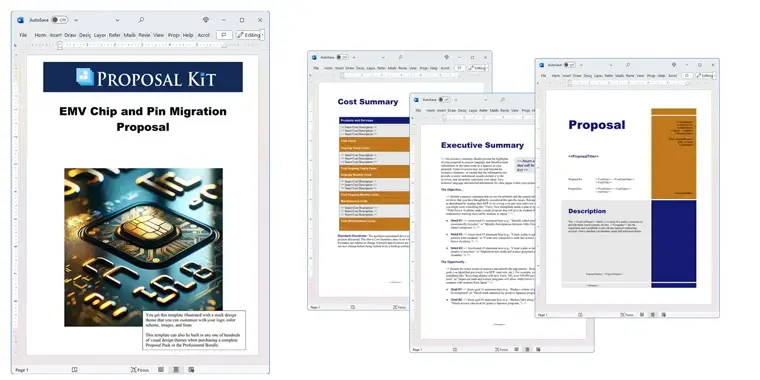How to write your EMV Chip and Pin Migration Proposal
We include this 24 page layout with every Proposal Pack. If you want this template to have a different visual design theme than the one illustrated here, purchase any Proposal Pack design and create this template using the purchased design theme. This template is included in every Proposal Pack. If you get a Proposal Pack or the Professional Bundle, you can also make any variation of this template with different chapters to suit your needs.
We typically include more chapters in the templates than most people will need to give everyone more variety in the chapters they may need. You can trim down a long template by removing pages you do not need or combining multiple chapter topics into one page.
 DOWNLOADABLE, ONE-TIME COST, NO SUBSCRIPTION FEES
DOWNLOADABLE, ONE-TIME COST, NO SUBSCRIPTION FEES If you need this template on DVD media order from our Amazon shop.
If you need this template on DVD media order from our Amazon shop.
You can also create countless variations of this document to suit your needs using the included library of 2200+ chapters if ordering a Proposal Pack or Pro Bundle.
 What Our Clients Say
What Our Clients SayYour proposal kit was very useful. We will keep in touch!"
Related Article
Related Video
Related Templates
- Software Installation and Training Proposal
- Technology Strategy Analysis
- Software System Testing Project Proposal
- Software Automation Proposal
- Technology Business Plan
- Software and Hardware System Proposal
- Custom Software Development Proposal
- Mobile App Software Development Proposal
- Sales and Inventory System Development Proposal
- Web Site Creation and Software Integration Project
- Managed Services IT Proposal
- Employee Security Card Proposal
- Cybersecurity Proposal Template
What's the best way to write your EMV chip and pin migration proposal?
A proven way to create an EMV chip and pin migration proposal is to use the Proposal Kit template and software package. This tool is specifically designed to guide users who may lack extensive proposal writing experience, offering a comprehensive and structured approach to creating a detailed and convincing proposal.
If you are in this situation or facing a similar challenge, consider how the Proposal Kit can streamline your proposal development process.
What Types of Projects Are EMV Chip and Pin Migration Proposals Written For?
EMV chip and pin migration projects enhance transaction security and minimize fraud risks. These projects typically involve:
- Upgrading POS systems to support EMV technology.
- Implementing chip-enabled credit card terminals across retail locations.
- Training staff on new payment processing procedures.
- Integrating EMV chip technology with existing financial software.
- Conducting pilot testing to ensure system functionality.
- Updating customer payment interfaces for secure chip transactions.
- Establishing compliance with international payment standards.
- Retrofitting ATMs to accept chip and pin verification.
- Developing encryption protocols for transaction data.
- Rolling out customer awareness campaigns about the security benefits of chip and pin.
Chapters this template is built with
Each section of your proposal can be written using the Proposal Kit's diverse templates.
These templates are just a sample from the thousands available in the Proposal Kit library, allowing you to comprehensively customize your proposal to address all pertinent topics.
Cover Letter
Begin your proposal with a personal greeting to the recipient, setting a professional yet engaging tone. Express your organization's commitment to enhancing transaction security through the proposed EMV chip and pin migration. Highlight your dedication to safeguarding customer data and ensuring the integrity of every transaction, emphasizing that this project is a move towards achieving unparalleled security standards.
Executive Summary
In the executive summary, concisely outline the scope and objectives of the EMV chip and pin migration. Summarize key points such as the necessity of the upgrade, the expected improvements in security, and the overall benefits to the client. This section should provide a snapshot of what the migration entails and what it aims to achieve, setting the stage for the following detailed proposal.
Challenges
Detail the current security challenges and limitations of the existing payment systems. Discuss issues such as the prevalence of skimming, the vulnerability of magnetic stripe cards, and any recent security breaches that have impacted the industry. This section should create a case for why the migration to EMV technology is beneficial and necessary.
Goals and Objectives
Clearly articulate the anticipated outcomes of the EMV migration. Goals might include reducing fraud rates, complying with global payment standards, and enhancing customer trust. Objectives should be specific, measurable, attainable, relevant, and time-bound (SMART), providing clear targets for the project'sproject's success.
Expectations
Outline what the client should expect both during and after the migration process. Include timelines, potential disruptions, support available during the transition, and how business operations will be affected in the short term. This transparency helps manage client expectations and prepares them for the process ahead.
Solutions
Detail the technological solutions that will be implemented during the migration. Describe the new EMV-enabled devices, the encryption methodologies, and any software updates necessary to support chip and pin technology. Highlight how these solutions address the previously mentioned challenges and contribute to the goals and objectives.
Transactions
Discuss how migration to EMV technology will affect and improve transactions. Explain the reduction in transaction times, increased security during point-of-sale interactions, and the long-term benefits of adopting a more resistant system to fraud.
Migration
Describe the step-by-step process of the EMV migration, from the initial planning stages to full implementation. Include phases such as assessment, equipment installation, staff training, system testing, and go-live. This section should provide a clear roadmap, helping the client understand each phase and its significance.
Impact Statement
Analyze the potential impacts of the EMV migration on business operations. Discuss the positive outcomes, such as improved security and compliance, and any challenges, such as initial costs or learning curves for staff. This balanced view helps stakeholders make informed decisions.
Security
Emphasize the enhanced security features of the EMV system, such as chip technology, that make card cloning and fraud significantly more difficult. Also, highlight the benefits of real-time authentication, which ensures each transaction is uniquely encrypted.
Equipment
List the necessary equipment upgrades required for the migration, including new point-of-sale terminals and ATMs capable of reading chip cards. Specify any additional security features these devices offer over the current equipment.
Hardware and Software
Specify the hardware upgrades and software updates required to support EMV compliance. Detail the specifications of compatible systems and any vendor requirements for integration.
Fraud
Explain how the migration to EMV technology will reduce instances of fraud. Discuss statistical evidence or case studies demonstrating EMV technology's effectiveness in reducing fraud in other markets or sectors.
Assumptions
State any assumptions that guide the proposal's strategies, such as the client's current technological capabilities, the regulatory environment, or market trends that affect the implementation of the project.
Cost Analysis
Provide a detailed breakdown of the projected costs associated with the EMV migration, including hardware, software, training, and any downtime associated with the installation. This transparency in cost estimation helps clients budget for the project.
Hidden Costs
Alert the client to any unforeseen expenses during the migration, such as additional training needs, unexpected technical challenges, or maintenance costs. This section helps prevent surprises and builds trust through transparency.
Economic Cost
Discuss the economic implications of not implementing the EMV migration, such as potential fines for non-compliance, lost revenue from fraud, and damage to the company's reputation.
Recommendations
Offer well-founded recommendations for the migration process based on industry best practices and the client's specific needs. Suggest timelines, project management strategies, and post-implementation reviews.
Conclusions
Draw thoughtful conclusions based on the information presented throughout the proposal. Reinforce how the EMV migration will benefit the client in terms of security, compliance, and customer trust.
Disclosures
Include any legal or regulatory disclosures related to the EMV migration to ensure full compliance with applicable laws and regulations.
Use cases for this template
Securing Retail Transactions at TechTrend Retailers
Evelyn, the owner of TechTrend Retailers, was at a juncture when it became evident that her store's payment systems were outdated and vulnerable to security breaches. Determined to secure customer transactions and future-proof her business, Evelyn sought to upgrade to EMV chip and pin technology. Knowing this upgrade required technical changes and substantial funding, she needed to create a persuasive business proposal to secure funding.
Using the Proposal Kit, Evelyn created a proposal that highlighted the critical need for updated security measures and showcased a phased implementation plan that would minimize disruption to her business operations. The templates from the Proposal Kit allowed her to outline each stage of the upgrade, from initial hardware installation to staff training and complete system deployment.
Her proposal communicated the return on investment through reduced fraud risks and enhanced customer confidence, leading to acceptance from her lender. The success of her proposal enabled Evelyn to modernize her payment systems, ultimately securing her retail transactions and increasing her business resilience.
Fast-Tracking Compliance at QuickServe Restaurants
Marco, the operations manager at QuickServe Restaurants, faced a challenge when new regulatory requirements demanded a rapid migration to EMV systems. Marco turned to Proposal Kit for a structured and efficient solution with a deadline looming and the need to maintain uninterrupted customer service. He leveraged the software to access templates designed for compliance-related proposals, ensuring that every critical aspect of the migration was covered.
Marco employed AI tools to refine his proposal further and tailor the content to his company's specific needs, using data-driven insights to highlight the upgrade's urgency and benefits. This blend of Proposal Kit's robust templates and AI-enhanced customization allowed Marco to develop a proposal clearly articulating the project's scope, budget, and timeline. His approach met the compliance deadline and demonstrated his capacity to manage critical operational challenges.
Championing Security at Global Aid Network
As the director of Global Aid Network, Nina recognized the imperative need to safeguard donor transactions against increasing cyber fraud threats. With the non-profit sector particularly vulnerable due to limited resources, Nina was determined to implement EMV technology to protect donor data and preserve trust. She used the Proposal Kit to draft a Request for Proposal (RFP) detailing potential vendors' security specifications.
The Proposal Kit templates gave Nina a clear framework to outline her requirements, including compliance with specific security standards and integration with existing financial systems. The comprehensive nature of the Proposal Kit helped ensure that all potential vendors were fully informed of the project's scope and expectations, facilitating a transparent and competitive bidding process.
The responses she received were of high caliber, but one vendor stood out with their combination of technological expertise and cost-effectiveness. Nina's successful use of the Proposal Kit not only secured the best vendor for the project but also reinforced the organization's commitment to donor security, enhancing its reputation among supporters and stakeholders.
Conclusions and Recommendations
Drafting an EMV chip and pin migration proposal with the Proposal Kit ensures a structured, clear, and comprehensive approach, making it an indispensable tool for anyone tasked with this responsibility. From the initial cover letter to the final disclosures, each part of your proposal can be written to secure the approval and funding necessary for successful EMV migration. A well-prepared EMV chip and pin migration proposal enhances security and supports seamless business operations.
Also Known As
This template may also be referred to in different ways or be used in more specialized situations, such as:
- EMV Technology Upgrade Proposal
- Chip and Pin Implementation Plan
- EMV Card Migration Funding Proposal
- Payment Security Enhancement Proposal
- EMV Compliance Transition Proposal
- Chip Card Migration Strategy
- EMV Adoption Business Case
- Secure Payment System Upgrade Proposal
- EMV Card Technology Integration Proposal
- Chip and Pin Conversion Project Plan
Abstract
 EMV chip and pin technology represents a significant advancement in securing financial transactions, offering encryption that makes card fraud more difficult, unlike traditional magnetic stripe cards. These chip card transactions are designed to reduce the risks associated with lost or stolen cards using encrypted data and requiring a unique authentication process for each use. As major card brands like Mastercard, Visa, American Express, and Discover push for a global shift to EMV cards, card issuers, and acquirers are working to ensure seamless integration and enhanced security. The EMV migration forum advocates for this transition, emphasizing the reduction in counterfeit card fraud and improvement in global interoperability.
EMV chip and pin technology represents a significant advancement in securing financial transactions, offering encryption that makes card fraud more difficult, unlike traditional magnetic stripe cards. These chip card transactions are designed to reduce the risks associated with lost or stolen cards using encrypted data and requiring a unique authentication process for each use. As major card brands like Mastercard, Visa, American Express, and Discover push for a global shift to EMV cards, card issuers, and acquirers are working to ensure seamless integration and enhanced security. The EMV migration forum advocates for this transition, emphasizing the reduction in counterfeit card fraud and improvement in global interoperability.
The migration to EMV chip cards is a comprehensive process involving upgraded POS terminals, financial institutions' systems, and consumer education. For merchants, it means adopting new contactless and chip-enabled terminals that offer secure card-present transactions, and for consumers, it enhances security during contactless transactions. Card issuers are tasked with the issuance of these new cards, ensuring that both online pins and mobile payments are secure. The shift also involves a liability shift, where merchants and banks are encouraged to adopt EMV technology to minimize risks associated with CNP fraud.
In addition to security enhancements, EMV chip cards support a range of payment options, from ticket kiosks to mobile and contactless transactions, offering flexibility and convenience to cardholders. As IT teams work on ensuring compliance with payment networks' standards, the focus remains on reducing card data breaches and protecting cardholder information across various platforms. With the backdrop of a threat landscape, EMV technology provides a robust solution to combat fraudsters and protect both new customers and existing consumers from the impacts of stolen card data. This implementation ensures financial institutions and merchants maintain consumer trust and secure transaction environments, ultimately driving forward the future of secure payments.
 The transition to EMV chip and pin systems is an important step for financial institutions and merchants to combat the increasing sophistication of fraudsters and secure sensitive card data. Unlike traditional magnetic stripe cards, EMV cards provide enhanced protection through encrypted data, making it nearly impossible for thieves to clone or misuse card information. Card issuers, including major players like Mastercard and Visa, are at the forefront of this technological migration, supporting card data security through improved EMV transactions.
The transition to EMV chip and pin systems is an important step for financial institutions and merchants to combat the increasing sophistication of fraudsters and secure sensitive card data. Unlike traditional magnetic stripe cards, EMV cards provide enhanced protection through encrypted data, making it nearly impossible for thieves to clone or misuse card information. Card issuers, including major players like Mastercard and Visa, are at the forefront of this technological migration, supporting card data security through improved EMV transactions.
Chip card transactions also mitigate the risks associated with lost or stolen cards by requiring a personal identification number (PIN) or signature at the point of sale (POS) terminal. This ensures that only the cardholder can authorize transactions, adding an extra layer of security. As financial institutions and merchants embrace these changes, they must also invest in upgrading their infrastructure, such as retrofitting ATMs and installing EMV-compliant POS terminals across retail locations. This infrastructure overhaul fosters a more secure payment ecosystem, reducing the likelihood of card-present fraud.
Incorporating EMV technology is not just about preventing card fraud; it also aligns with global interoperability standards, ensuring that cardholders can seamlessly conduct transactions across different regions. This is particularly important as payment networks evolve, supporting diverse methods like contactless cards and mobile payments. For merchants, this means being prepared to verify transactions using modern methods that accommodate both contact and contactless interactions, thus catering to a wider range of consumer preferences.
 The EMV migration also involves comprehensive staff training and customer awareness campaigns, equipping employees and consumers with the knowledge needed to navigate new payment interfaces confidently. Its teams play an important role in this transition, ensuring that both the hardware and software topics are up-to-date and compliant with industry standards. The issuance of EMV chip cards is a proactive measure against potential liabilities and an approach to fortify against CNP fraud, which remains a challenge in online transactions.
The EMV migration also involves comprehensive staff training and customer awareness campaigns, equipping employees and consumers with the knowledge needed to navigate new payment interfaces confidently. Its teams play an important role in this transition, ensuring that both the hardware and software topics are up-to-date and compliant with industry standards. The issuance of EMV chip cards is a proactive measure against potential liabilities and an approach to fortify against CNP fraud, which remains a challenge in online transactions.
As merchants and banks navigate this shift, the Proposal Kit offers valuable resources, including templates, to aid in writing thorough proposals that address all facets of the migration. These tools help stakeholders outline the cost implications, potential challenges, and solutions necessary for a successful transition. By embracing EMV chip technology, businesses not only safeguard their operations but also enhance customer trust, thus fostering long-term loyalty and securing a competitive edge in the financial marketplace.
Frequently Asked Questions
What should be included in an EMV Chip and Pin Migration Proposal?
Start with an Executive Summary that provides an overview of the proposal, highlighting the importance and benefits of migrating to EMV technology. Next, detail the Project Scope, which should include the migration project's objectives, timeline, and key milestones. A thorough Cost Analysis is crucial, breaking down the expenses involved, including hardware, software, and implementation costs. Include a Risk Assessment to identify potential risks and outline strategies to mitigate them. Finally, explain how the migration will ensure Compliance and Regulatory Requirements are met, addressing relevant industry standards and regulations.
In my proposal, how do I justify the costs associated with migrating to EMV technology?
Justifying the costs associated with migrating to EMV technology involves emphasizing the long-term benefits and financial savings. Highlight the enhanced security, reduced fraud, and improved customer trust that EMV migration will bring. Include a detailed Cost-Benefit Analysis to show how the investment will lead to cost savings through reduced fraud and chargebacks. Provide Industry Comparisons with examples and case studies of other businesses that have successfully migrated to EMV and the financial benefits they experienced. Stress the importance of Regulatory Compliance to avoid potential fines and penalties for non-compliance, reinforcing the necessity of the investment.
What are challenges faced during EMV migration, and how can they be addressed in the proposal?
Technical Issues can be mitigated by outlining a robust implementation plan that includes thorough testing phases and technical support. Effective Cost management can be achieved by proposing phased implementation and seeking vendor partnerships for cost-sharing opportunities. Emphasize the importance of Staff Training on the new EMV technology and propose a comprehensive training program to ensure smooth adoption. To facilitate Customer Adaptation, discuss plans to educate customers about the new payment system, ensuring a seamless transition and acceptance.
How do I ensure my EMV Chip and Pin Migration Proposal meets industry standards and regulatory requirements?
Conduct thorough research and reference relevant standards, such as PCI DSS (Payment Card Industry Data Security Standard) and EMVCo specifications, which are essential. Consulting with compliance experts or vendors specializing in EMV technology can provide additional assurance that all regulatory requirements are addressed. Include a Detailed Compliance Plan in your proposal, outlining how each aspect of the migration will meet or exceed regulatory standards. To reinforce your commitment to regulatory adherence, provide clear documentation of compliance measures, such as data encryption protocols and secure transaction processes.
What metrics should I use to measure the success of the EMV migration project in my proposal?
Include metrics such as the Reduction in Fraud and monitoring the decrease in fraudulent transactions post-migration. Track Transaction Approval Rates to ensure the system functions efficiently and maintains high approval rates. Collect and analyze Customer Feedback to gauge their satisfaction with the new payment system. Regularly review and document Compliance Status with industry standards and regulatory requirements to ensure ongoing adherence. Finally, cost savings are measured by comparing the financial impact, including savings from reduced fraud and chargebacks, against the initial investment in EMV technology, demonstrating the overall financial benefits of the migration.
15% Off Discount
![]() Add To Cart This Word Template Only
Add To Cart This Word Template Only
 Add To Cart Proposal Pack for Any Business
Add To Cart Proposal Pack for Any Business
 Add To Cart Proposal Kit Professional Bundle
Add To Cart Proposal Kit Professional Bundle
 4.7 stars, based on 846 reviews
4.7 stars, based on 846 reviewsProposal Kit chapters used in this template
Cover Letter, Title Page, Table of Contents, Executive Summary, Goals and Objectives, Disclosures, Assumptions, Expectations, Challenges, Migration, Solutions, Transactions, Security, Fraud, Impact Statement, Guidelines, Hardware and Software, Equipment, Hidden Costs, Economic Cost, Cost Analysis, Conclusions, Recommendations, Back Page
Included Calculator Spreadheets
These Excel calculator spreadsheets are included with this template. If you purchase a Proposal Pack or the Professional Bundle, these proposal pages are generated using an automated line-item database in the included Wizard software. The calculator spreadsheets are intended for use when purchasing only the static Word template.
You use this proposal for
- General business proposal
- Technical proposal
- Project pitch proposal
- Internal company proposal
- IT, software, hardware proposal
How to create this template with Proposal Pack Wizard
You can create this document using any of the logo-designed Proposal Packs. Pick any Proposal Pack with a logo design theme you like best; they will all work equally well. The Proposal Pack for Any Business is the pack with no extra added logos or colors - designed to be used plain or for you to customize with your logos and graphics.
The Proposal Pack design theme you purchase will determine the visual look of this template. The screenshot above only shows the plain generic design theme. Names and stories in examples are fictional; however, the templates are from real client use cases.
We include a library of chapters to be assembled based on your needs. All proposals are different and have different needs and goals. We designed Proposal Pack so you can customize the documents to suit your needs.
You will best create this document using the Proposal Pack Wizard - Expert Edition software to select this template and build it in the Proposal Pack logo design theme of your choice along with any desired customizations (such as adding additional chapters, removing unneeded chapters, changing the order of chapters, and importing your company logo). This template outlines a proposal for the described situation. Each user is responsible for typing in the actual content of the provided pages with their information to complete the proposal. Suggestions in the abstract may include features in higher-end packages and are facilitated by the selection of chapter templates to support the narrative of each proposal, which help guide the user in filling in the details.
You create this template using the Wizard software with an entire Proposal Pack library and software. We include the Expert Edition of the software in the Proposal Kit Professional bundle. Microsoft Word for Windows is required to use the customizing software. You can also edit Word document templates in other office software such as Word for Mac. We will assist Mac users in assembling complex templates for their first project if they do not have the required platform to run the Wizard software.
You only get the single assembled Word document if purchased as a stand-alone template. The individual template products include no other templates, samples, or software.
How to Build Templates Featured on Proposal Kit Website
Many people find the Proposal Kit website after searching for a specific proposal. Once you've purchased and installed the software, how do you build that template you found in the first place? This video shows you how to build any proposal you see on the Proposal Kit website.
Key Takeaways
- The EMV Chip and Pin Migration Proposal is available as a ready-to-edit template.
- You can create unlimited custom variations of this template using a Proposal Pack or the Professional Bundle.
- Using a Proposal Pack or Professional Bundle, you can automate quotes and other financial pages with a line-item database.
- There are no ongoing subscription fees. You get lifetime unlimited use.
- We made Proposal Kit for freelancers, small businesses, and non-profits.
- Proposal Kit product content (templates, samples, software) is 100% written by humans.
 Ian Lauder has been helping businesses write their proposals and contracts for two decades. Ian is the owner and founder of Proposal Kit, one of the original sources of business proposal and contract software products started in 1997.
Ian Lauder has been helping businesses write their proposals and contracts for two decades. Ian is the owner and founder of Proposal Kit, one of the original sources of business proposal and contract software products started in 1997.By Ian Lauder
 Published by Proposal Kit, Inc.
Published by Proposal Kit, Inc.


 Cart
Cart


 Get 15% off ordering today:
Get 15% off ordering today: 

 Facebook
Facebook YouTube
YouTube X
X Search Site
Search Site